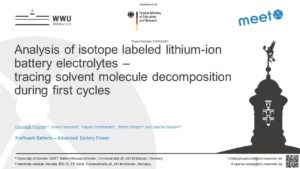Summary:
The instability of state-of-the-art lithium-ion battery (LIB) electrolytes against applied electrode potentials results in redox reactions at the electrode/electrolyte interfaces. Especially during the first charge and discharge cycles, the solid electrolyte interphase (SEI) is formed on the negative electrode caused by solvent molecule and conducting salt decomposition. A sufficient interphase formation in LIBs limits ongoing decomposition of the electrolyte and is crucial for their long-term performance and safety. However, despite the importance of electrolyte decomposition reactions during interphase formation, knowledge about underlying reactivities and intermediates remains limited.[1] To further clarify these reactions, isotope labeling of solvent molecules is a promising approach for differentiation between linear and cyclic carbonate aging via tracing of isotope labeled atoms in occurring decomposition species. Based on defined atom origins, reaction pathways and intermediates resulting in observed labeling distributions can be evaluated.[2,3]
This work reports on the analysis of 13C isotope labeled ethylene carbonate containing electrolytes after cell formation. Gas chromatography – mass spectrometry-based techniques were applied to identify mass shifts in labeled decomposition species. Moreover, fragmentation experiments were performed to define the molecular positions of labeled atoms. Based on this, the origins of molecule entities were referred to the linear and cyclic carbonate, respectively. Finally, reaction pathways resulting in oligomeric carbonates and phosphate carbonates were adressed, regarding their consistency with the experementally determined atom origins.
[1] M. Winter, Z. Phys. Chem. 2009, 223, 1395-1406.
[2] A. L. Michan et al., Chem. Mater. 2016, 28, 385-398.
[3] J. Henschel et al., Angew. Chem. Int. Ed. 2020, 59, 6128-6137.
We are happy to forward your request / feedback.

